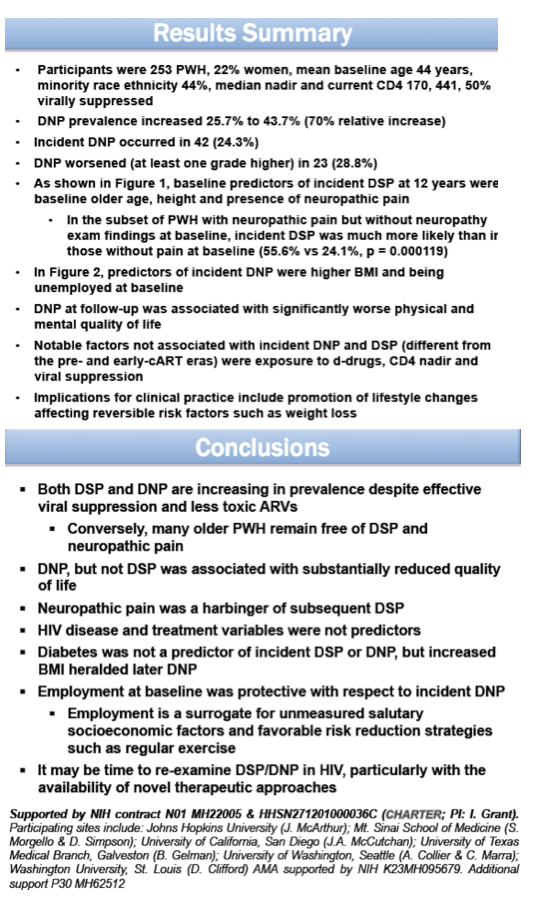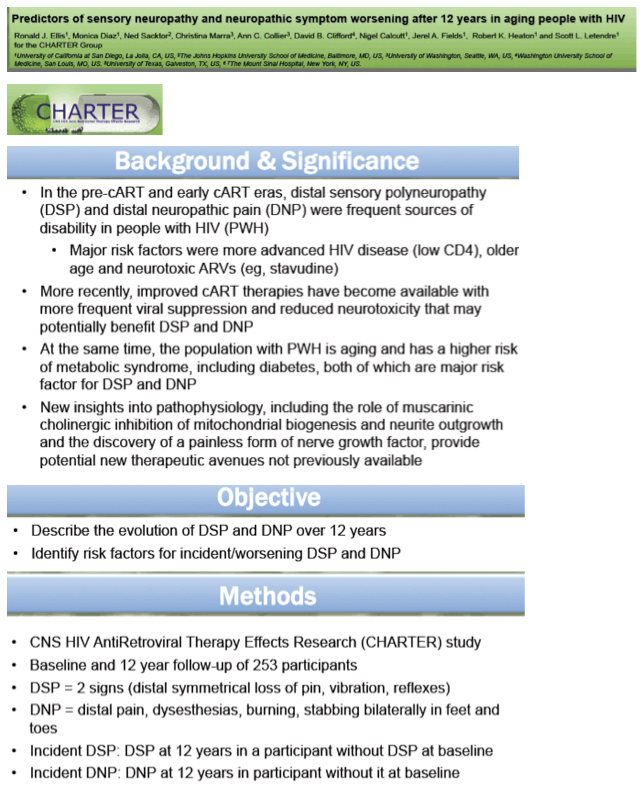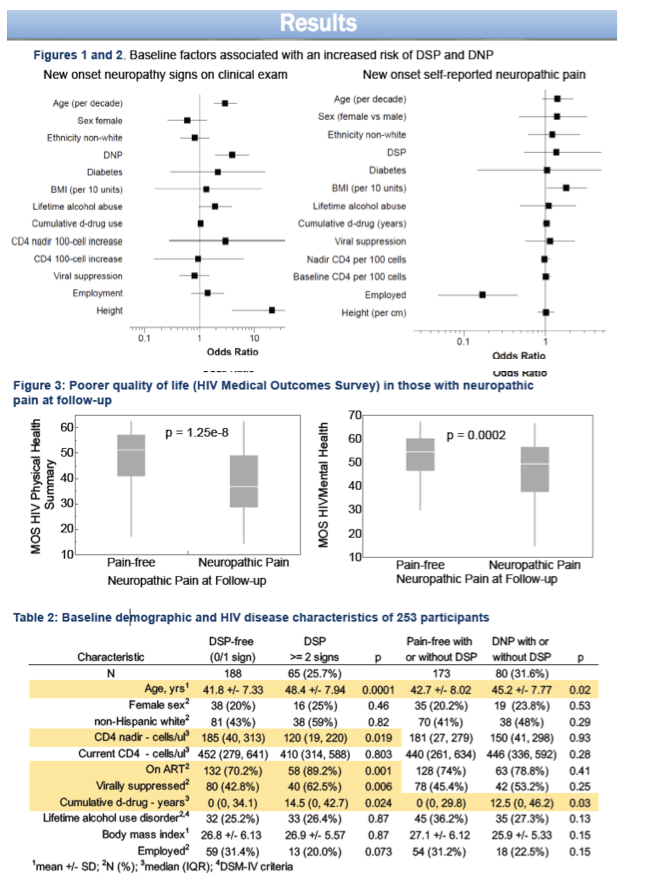 |
 |
 |
| |
Neuropathy and Neuropathic Pain Still on Rise in HIV+, But No Clear Links to ART
|
| |
| |
AIDS 2020: 23rd International AIDS Conference Virtual, July 6-10, 2020
Mark Mascolini
Distal sensory polyneuropathy (DSP) and distal neuropathic pain (DNP) continue to affect growing proportions of people with HIV infection, despite more effective and less toxic antiretroviral therapy (ART), report US CHARTER study researchers [1]. Yet many older people with HIV remain free of either affliction, and HIV disease and treatment variables did not predict these conditions in this 12-year analysis.
In the early days of ART, including early combination ART, low CD4 count, older age, and neurotoxic antiretrovirals such as stavudine (d4T) emerged as major risk factors for DSP and DNP. But it is unclear whether those variables still predict neuropathic disease in the current antiretroviral era. The researchers argued that improved understanding of the pathophysiology of these conditions and potentially promising new therapies compel up-to-date research on DSP and DNP prevalence and risk factors.
Toward that end, Ronald Ellis and US CHARTER* study colleagues set out to describe the evolution of DSP and DNP over 12 years in people with HIV and to identify risk factors for new or worsening DSP and DNP. They defined DSP as two signs of polyneuropathy (including distal symmetric loss of pin or vibration sensation or reflexes). DNP meant distal pain, dysesthesias, burning, and stabbing bilaterally in the feet and toes.
The analysis involved 253 CHARTER participants who had relevant DSP and DNP measures at baseline and 12 years later. Baseline age averaged 44 years, 22% of participants were women, and 44% were racial/ethnic minorities. Median nadir and current CD4 count at baseline were 170 and 441, and 50% had an undetectable viral load.
At the baseline visit, 65 of these people (26%) had DSP and 80 (32%) had DNP with or without DSP. Factors that distinguished people with versus without baseline DSP were older age (average 48.4 versus 41.8, P = 0.0001), lower nadir CD4 count (median 120 versus 185, P = 0.019), receiving ART (89% versus 70%, P = 0.001), having an undetectable viral load (62.5% versus 43%, P = 0.006), and cumulative exposure to d-drugs (d4T, ddI, ddC) (median 14.5 versus 0 years, P = 0.024). People with versus without baseline DNP were older (average 45.2 versus 42.7, P = 0.02) and had taken d-drugs longer (median 12.5 versus 0 years, P = 0.03).
Having neuropathic pain during follow-up (versus being pain-free) significantly impaired quality of life measured on the HIV Medical Outcomes Survey for both physical health (P = 1.25e-8) and for mental health (P = 0.0002) .
During follow-up, DNP prevalence rose from 26% of 44%, a 70% relative increase. New-onset DNP arose in 42 people (24% of those without baseline DNP), and DNP worsened by at least 1 grade in 23 people (29%). In a subset of people with DNP but without neuropathy exam results at baseline, new-onset DSP was significantly more likely than in people without pain at baseline (56% versus 24%, P = 0.000119).
Three factors independently predicted DSP onset in 12 years of follow-up: older age, DNP, and greater height (nerve fiber length increases with height, resulting in more axon surface area that can be exposed to toxins or physical damage). Lifetime alcohol abuse also tended to favor development of DSP. Greater body mass index independently raised the risk of new-onset DNP, while employment lowered the risk.
Factors not associated with development of DNP or DSP in this new analysis included exposure to d-drugs, CD4 nadir, and viral suppression. These factors had been DNP or DSP predictors in the early ART and early combination ART eras.
The CHARTER team concluded that prevalence of both DSP and DNP is rising in the current treatment era despite more consistent and durable HIV suppression and availability of less toxic antiretrovirals. DNP presaged subsequent DSP. The researchers suggested that employment was linked to a lower risk of new DNP because it is a surrogate of "unmeasured salutary socioeconomic factors and favorable risk reduction strategies such as regular exercise."
Although diabetes did not predict incident DSP or DNP in this analysis, higher weight did predict DNP. The researchers urged colleagues to address this reversible risk factor. Given the novel therapies becoming available for DSP and DNP, the CHARTER investigators called for an overall reexamination of these conditions in people with HIV.
*CNS HIV AntiRetroviral Therapy Effects Research.
Reference
1. Ellis RJ, Diaz M, Sacktor N, et al. Predictors of sensory neuropathy and neuropathic symptom worsening after 12 years in aging people with HIV. AIDS 2020: 23rd International AIDS Conference Virtual. July 6-10, 2020. Abstract PEA0088.
Predictors of sensory neuropathy and neuropathic symptom worsening after 12 years in aging people with HIV
Ronald J. Ellis1, Monica Diaz1, Ned Sacktor2, Christina Marra3, Ann C. Collier3, David B. Clifford4, Nigel Calcutt1, Jerel A. Fields1, Robert K. Heaton1 and Scott L. Letendre1
for the CHARTER Group
1University of California at San Diego, La Jolla, CA, US, 2The Johns Hopkins University School of Medicine, Baltimore, MD, US, 3University of Washington, Seattle, WA, US, 4Washington University School of Medicine, San Louis, MO, US. 5University of Texas, Galveston, TX, US, 6 7The Mount Sinai Hospital, New York, NY, US.



|
| |
|
 |
 |
|
|